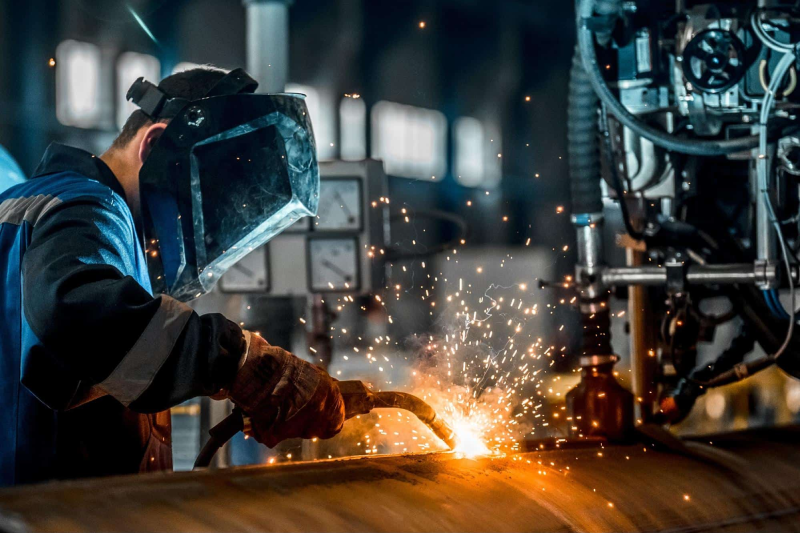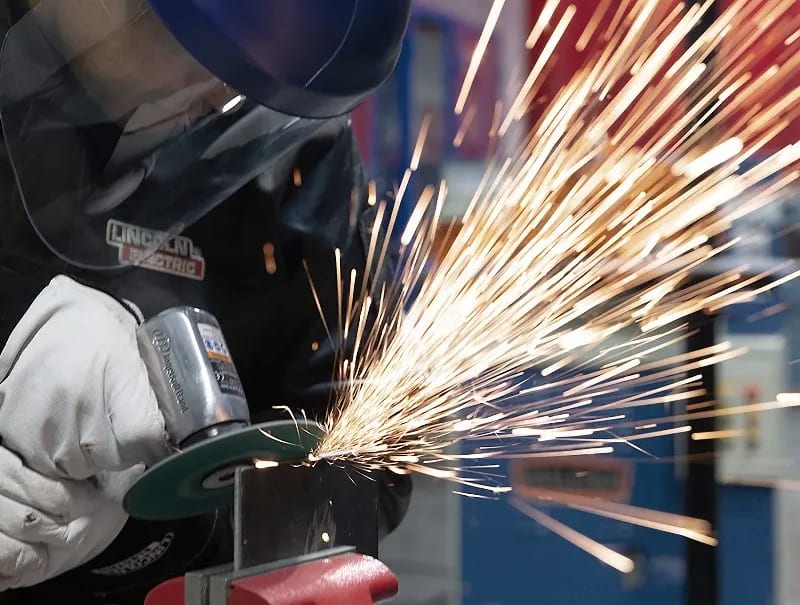Everything about Welding: Trick Insights Into Techniques and Ideal Practices for Success
Welding incorporates a selection of methods, each suited for details products and applications. Recognizing these methods, such as GMAW, SMAW, and TIG, is important for attaining perfect results. The best devices and safety and security practices can not be overlooked. As preparation and repairing play important functions in the welding process, mastering these components can significantly boost the quality of the end product. What are the crucial variables that guarantee a successful weld?
Recognizing Various Welding Techniques
Welding methods incorporate a variety of techniques, each fit to certain applications and materials. Amongst one of the most usual techniques are Gas Steel Arc Welding (GMAW), Secured Steel Arc Welding (SMAW), and Tungsten Inert Gas Welding (TIG) GMAW, likewise referred to as MIG welding, is prominent for its rate and flexibility, making it excellent for slim products. SMAW, or stick welding, is favored for its simpleness and effectiveness in outdoor environments, particularly with thicker metals. TIG welding offers accuracy and control, making it suitable for elaborate work and non-ferrous steels (Belgrade Welding). Each technique has its one-of-a-kind benefits and factors to consider, allowing welders to pick the very best approach based upon the project's needs, product kind, and preferred outcomes. Recognizing these strategies is essential for effective welding
Important Welding Tools and Devices
While different welding techniques require specific skills, the ideal equipment and tools are just as necessary for accomplishing high quality results. Essential welding equipment includes welding machines, which differ depending on the strategy-- such as MIG, TIG, or stick welding. Protective equipment, consisting of headgears, aprons, and handwear covers, assurances security and convenience during the process. On top of that, clamps and fixtures aid protect products in position, making sure accuracy in welds. Consumables like welding rods, cable, and securing gas are additionally critical elements that affect the top quality of the weld. Devices such as cutters and mills assist in surface area prep work and post-weld finishing, adding to a professional outcome. Purchasing top notch tools ultimately boosts the efficiency and efficiency of welding jobs.
Safety And Security Practices in Welding
Appropriate safety and security methods are crucial in the welding market to secure workers from prospective threats. Welders have to wear ideal individual protective tools (PPE), including helmets with appropriate shading, handwear covers, and flame-resistant garments. Sufficient ventilation is vital to decrease direct exposure to unsafe fumes and gases created throughout the welding process. In addition, workers ought to be trained in the proper handling of welding tools to prevent accidents. Fire precaution, such as keeping flammable products away from the welding area and having fire extinguishers conveniently available, are essential. Regular examinations of tools and workspaces can assist recognize possible dangers before they lead to crashes. By sticking to these security methods, welders can produce a safer working environment and minimize risks connected with their trade.
Readying Materials for Welding
Preparing materials for welding is an important action that substantially influences the top quality and stability of the end product (Montana Mobile Welding and Repair Welding). Proper prep work involves cleansing the surface areas to eliminate contaminants such as dirt, rust, and oil, which can endanger the weld. Techniques such as grinding, sanding, or utilizing solvents are typically used to achieve a tidy surface. Furthermore, ensuring that the products mesh snugly is vital; voids can cause weak welds. It's also crucial to take right into account the alignment and positioning of the components, as this will certainly affect the simplicity of welding and the last outcome. Lastly, choosing the ideal filler material and making sure compatibility with the base steels is necessary for achieving strong, resilient welds
Tips for Achieving High-Quality Welds
Achieving premium welds calls for focus to information and adherence to ideal methods throughout the welding process. Correct joint prep work is crucial, making certain surfaces are clean and cost-free from contaminants. Selecting the ideal filler product and welding method based upon the base metals is vital for optimal bonding. Keeping regular travel speed and angle while welding can promote and stop defects uniformity. In addition, managing heat input is essential; extreme warmth can lead to bending and deteriorated joints. If necessary, routinely evaluating the welds throughout the procedure allows for immediate changes. Ultimately, using ideal post-weld treatments, such as cleansing and stress and anxiety relief, can improve the longevity and stability of the weld, eventually making certain a successful end result.
Repairing Typical Welding Issues
Welding commonly presents obstacles that can impact the top quality and stability of the final item. Usual concerns such as porosity, irregular weld grains, and overheating can develop, each calling for specific repairing methods. Recognizing these issues is necessary for welders to boost their skills and accomplish perfect outcomes.
Porosity Problems Described
Porosity can typically be neglected, it stays a crucial concern in welding that can jeopardize the integrity of a completed product. Porosity describes the visibility of small gas pockets within the weld grain, which can lead and weaken the joint to early failure. This problem generally arises from pollutants, wetness, or incorrect shielding gas insurance coverage during the welding process. To mitigate porosity, welders must verify that the base products are tidy and dry, make use of proper shielding gases, and keep constant welding parameters. Frequently examining the tools and atmosphere can additionally aid identify potential problems prior to they show up in the weld. Dealing with porosity properly is crucial for achieving solid, long lasting welds that meet quality criteria.

Inconsistent Weld Beans
Inconsistent weld grains can significantly affect the high quality and toughness of a finished item. Numerous elements contribute to this concern, including inappropriate traveling speed, incorrect amperage settings, and inconsistent electrode angles. When the welder relocates as well rapidly, a grain may show up narrow and do not have infiltration, while moving also slowly can trigger extreme build-up. In addition, using the incorrect amperage can result in either undercutting or excessive spatter, both of which concession weld integrity. The welder's method, such as inconsistent lantern movement, can additionally bring about irregular grain look. To alleviate these issues, welders need to concentrate on keeping steady, controlled movements and guaranteeing appropriate devices settings to achieve uniformity in their welds. Consistency is vital to attaining reputable and solid welds.
Overheating and Warping Issues
Excessive warmth during the welding process can cause substantial getting too hot and warping concerns, affecting the structural honesty of the work surface. These troubles frequently materialize as distortion, which can compromise placement and fit-up, making further setting up challenging. Variables adding to overheating include the selection of welding parameters, such as voltage and take a trip speed, along with the type of material being welded. To reduce these problems, welders ought to keep consistent get more info travel rate and ideal heat input while monitoring the work surface temperature level. In addition, pre-heating or post-weld heat treatment can help ease stress and anxieties created by quick air conditioning - Montana Mobile Welding and Repair Fabrication. Routine evaluation and adherence to best practices are necessary in avoiding getting too hot and ensuring the longevity and dependability of bonded frameworks
Frequently Asked Inquiries
What Are the Profession Opportunities in the Welding Industry?
The welding sector uses varied profession chances, consisting of positions as welders, educators, engineers, and inspectors. Experts can work in manufacturing, building, aerospace, and vehicle markets, gaining from solid need and affordable incomes in different roles.
Just How Can I Improve My Welding Speed Without Giving Up Top Quality?
To boost welding speed without giving up high quality, one must practice reliable methods, preserve devices, optimize settings, and boost hand-eye coordination. Regular training and seeking comments can likewise substantially add to attaining quicker, top notch welds.
What Qualifications Are Available for Welders?
Countless accreditations exist for welders, including those from the American Welding Society (AWS), the National Center for Construction Education And Learning and Study (NCCER), and numerous industry-specific companies. These credentials improve employability and demonstrate skill efficiency.
Just How Does Welding Influence the Residences of Metals?
Welding affects the properties of metals by modifying their microstructure, which can lead to changes in solidity, ductility, and strength. Warmth input and air conditioning prices throughout the procedure significantly affect these material characteristics.
Can I Weld Dissimilar Metals With Each Other?
